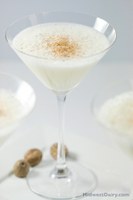Prairie Fare: Can Alcohol-containing Beverages Fit in a Healthful Diet?
(Click an image below to view a high-resolution image that can be downloaded)
By Julie Garden-Robinson, Food and Nutrition Specialist
NDSU Extension Service
When the holiday season rolls around, my younger daughter gets a gleam in her eye. She knows that eggnog will be “in season” at the grocery store. If I want a sample, I have to have a cup of it right away or hide the carton in the refrigerator we keep in the garage.
If the eggnog is kept in the refrigerator in our kitchen, I find an empty carton in the trash within a day. Last year, we had a difficult time finding eggnog in stores near us.
I like eggnog, too, especially with an extra sprinkle of nutmeg on top. The recipe I’m sharing this week is lower in calories than typical commercial eggnog.
Special beverages ranging from fruit punch to sparkling juice to a variety of alcohol-containing cocktails, wine and champagne also make regular appearances at this time of the year. Yes, sometimes people add alcohol to eggnog to make it an adult beverage, too.
Let’s begin with some safety reminders. If you choose to consume alcohol-containing beverages and are legally old enough to do so, moderation is important for many reasons. Adults should plan to have a designated nondrinking driver on occasions when they plan to indulge in alcohol-containing beverages. Pregnant women should not consume any alcohol.
Alcohol intake can affect medications. Be sure to discuss with your health-care provider and/or pharmacist the effects of alcohol consumption on prescription and nonprescription medications.
On the other hand, you may have read about red wine and other alcohol-containing beverages and their relationship to improving health. For example, researchers have noted that a compound (resveratrol) in red wine, as well as red and purple grape juice, may be linked to health benefits.
The antioxidant compounds in grapes may help reduce blood cholesterol and help you maintain a healthy blood pressure. Most of the research has been done on wine consumption instead of juice consumption.
Despite the research, the 2015 Dietary Guidelines for Americans does not recommend starting to drink alcohol if you haven’t consumed alcohol in the past. Adding alcohol to your diet does not offer great health advantages.
In other words, eat more whole fruit instead of drinking fermented fruit juice.
How can we ring in the New Year and enjoy some spirits if we choose? I think we all know that alcohol-containing beverages aren’t exactly easy on the waistline. Calories from beverages often do not satisfy hunger the way food calories do. If you are thirsty, go with water as your beverage of choice.
Remember “portion size” as it applies to alcohol-containing beverages, too. Each of these equals one “drink”: 12 fluid ounces of regular beer (5 percent alcohol), 5 fluid ounces of wine (12 percent alcohol) or 1.5 fluid ounces of 80 proof distilled spirits (40 percent alcohol).
If you consume alcohol, moderation is key. The Dietary Guidelines for Americans stresses a maximum of two alcoholic beverages per day for men and one alcoholic beverage per day for women.
Why is the daily limit lower for women than men? Women usually weigh less than men, and a woman’s body composition is different from that of a man. Women have less water in their bodies than men.
If a woman and man of the same weight each drink the same amount of alcohol, the woman will have a higher blood alcohol content, according to the National Institute on Alcohol Abuse and Alcoholism.
Drinking coffee or other caffeinated beverages will not change blood alcohol content. Only time will lower blood alcohol content.
If you like to have an occasional adult beverage, pace yourself. Enjoy a glass of wine, a mixed drink or a cup of “spiked” eggnog, then have a glass of water or sparkling juice as your follow-up drink. Always drink responsibly.
As I wrote this column one evening, I remembered that I still had a carton of eggnog in my garage refrigerator. My daughter hasn’t discovered it yet. Therefore, this was an eggnog-fueled column, free of any alcohol, by the way.
Here’s a delicious recipe for homemade eggnog courtesy of the Midwest Dairy Association. The nutrition analysis was done at NDSU. For safety, you must use pasteurized eggs or a pasteurized egg product. Pasteurized eggs have undergone a gentle heating process that inactivates bacteria (such as salmonella) that might be present. Look for eggs that are labeled as “pasteurized.” Do not substitute “regular” eggs, or those that aren’t labeled as “pasteurized.”
Homemade Vanilla Eggnog
3 pasteurized eggs (or 3/4 c. pasteurized egg product such as Egg Beaters)
1/3 c. sugar
4 c. low-fat milk
1 c. low-fat vanilla yogurt
1 tsp. pure vanilla extract
1/8 tsp. salt
Ground nutmeg (or grated whole nutmeg, if available)
In a blender, mix eggs and sugar. Add milk, yogurt, vanilla and salt; blend until frothy. Pour into serving glasses and garnish with freshly grated nutmeg.
Makes 10 servings. Each serving has 110 calories, 2.5 grams (g) fat, 6 g protein, 15 g carbohydrate, 0 g fiber and 115 milligrams sodium.
(Julie Garden-Robinson, Ph.D., R.D., L.R.D., is a North Dakota State University Extension Service food and nutrition specialist and professor in the Department of Health, Nutrition and Exercise Sciences.)
NDSU Agriculture Communication - Dec. 22, 2016
| Source: | Julie Garden-Robinson, 701-231-7187, julie.garden-robinson@ndsu.edu |
|---|---|
| Editor: | Ellen Crawford, 701-231-5391, ellen.crawford@ndsu.edu |



